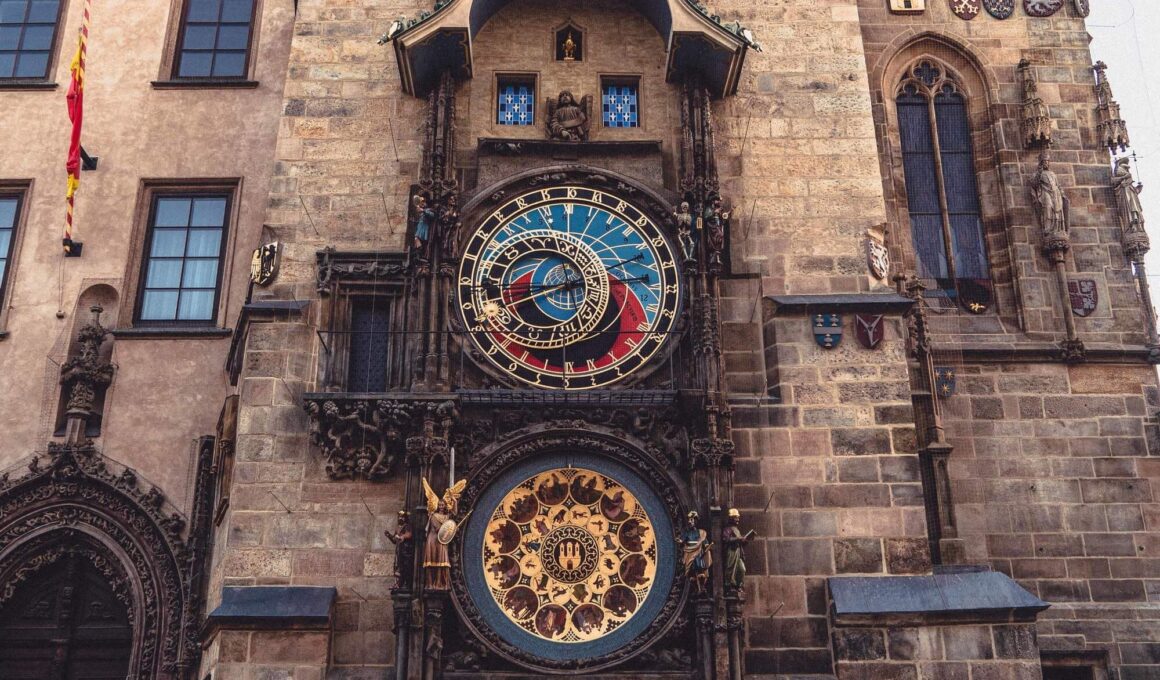Table of contents Show
Age of the Astronomical Clock
You’ve most likely heard about the 7 wonders of the world. But, have you heard of the mechanical wonder of Bohemia? Oftentimes, archeologists unravel wonderful things dating hundreds and thousands of years into the past. Through the lens of archeologists and historians, you get to see the picture of ancient civilizations. Despite these finds, there’s hardly any item of antiquity that’s still functional today. Well, that story changes with the ancient mechanical wonder of Bohemia – the Prague Astronomical Clock.
Standing as one of the most treasured cultural heritages, the Prague Astronomical Clock is a global wonder on its own. Millions of tourists pour into Prague yearly to visit and learn about this ancient wonder called the Prague City Astronomical Clock. The most mind-blowing feature of this Clock is that it’s still fully functional despite the fact that it’s well over six centuries old.
The Story of the Prague Astronomical Clock

The story of this ancient Clock dates as far back as 1410. Around October 1410, the masterful clockmaker Mikulas of Kadan began working on creating this magnificent clock. Thanks to his ingenious design, the clock was able to serve as both a basic clock, as well as an astronomical dial. Other than the fact that the clock was basically designed to tell time, it was perfectly functional in monitoring celestial movements. With the Prague Astronomical Clock, you can see the position, alignment as well as the movement of the stars and planets.
But then, as you may expect, this monstrosity of a Clock wasn’t built in one year. In fact, many credits the creation of the Prague Astronomical Clock to the second clockmaker, Jan Ruze. Why? The first clockmaker Mikulas of Kadan only worked on the clock mechanism and its astronomical dial. But the major work on the Prague Astronomical Clock began in 1490 by Jan Ruze who was mostly known as Master Hanus. Thanks to Master Hanus, beautiful gothic sculptures and a calendar dial were added to the clock. This amplified its functionality as it began serving 3 main purposes.
Here’s a little dark story about the Prague Astronomical Clock; after completing the clock, the Prague Council had Master Hanus blinded. Why? They didn’t want him to recreate the mechanical marvel elsewhere.
When was the Prague Astronomical Clock built?
Building the Prague Astronomical Clock wasn’t a one-shot move from start to finish. Rather, its building was scattered across the years. Building the Astronomical Clock first began in 1410 under the masterful hands of clockmaker Mikulas of Kadan. He was supported by Jan Sindel who was a professor of mathematics and astronomy. Their ingenious creation was later upgraded by Jan Ruze in 1490 to feature ornate gothic sculptures and a calendar dial. After the Council’s harsh decision to blind him, Jan Ruze spoiled the clock such that it could not be repaired till 1552.
After 1552, the Prague Astronomical Clock kept spoiling and getting fixed severally until around 1791. By this time, wooden statues of the Holy Apostles had been added to the whole structure. In 1866, a golden rooster was added to the magnificent clock which had begun gaining global attention. Unfortunately, the Prague Astronomical Clock was badly wrecked by the Nazis in 1945, and it remained mostly disfigured until 2005 when it was fully restored. In 2018, an extra renovation was done to the clock, and it has remained functional and beautifully maintained till today.
Is it possible to visit the Prague Astronomical Clock?

Reading up on this marvelous creation would no doubt push you to check it out. But here’s the deal, you can only check out the Prague Astronomical Clock during the following opening hours:
11:00 am to 7:00 pm on Mondays all through January to September.
11:00 am to 8:00 pm on Mondays from October to December.
9:00 am to 7:00 pm from Tuesday to Sunday all through January to September.
9:00 am to 8:00 pm from Tuesday to Sunday all through October to December.
You’ll need an entrance fee of 250 CZK for basic entry or 500 CZK for family entry.
Explore the Astronomical Clock
Discover the captivating history and architectural wonders of Prague on a guided walking tour that takes you from the charming Old Town to the vibrant New Town. Immerse yourself in centuries of Czech history, marvel at iconic landmarks, and enjoy panoramic views of the city from the Astronomical Clock Tower.
Highlights
- Explore the magnificent Gothic-style Astronomical Clock Tower and enjoy breathtaking panoramic views of Prague from its vantage point.
- Embark on a guided walking tour that takes you from the historic Old Town Square to the modern New Town, delving into the rich history of the city.
- Learn fascinating insights about Czech history and the development of Prague from the 9th to the 20th centuries.
- Marvel at the architectural wonders of historic houses, palaces, churches, theaters, and more, each with their own stories to tell.
- Venture into the New Town area, where significant events in Prague’s modern history unfolded, offering a glimpse into the city’s vibrant past.
Included
- Knowledgeable tour guide to lead you through the city, providing valuable historical and cultural commentary. – Admission ticket granting access to the Astronomical Clock Tower, allowing you to admire its Gothic splendor and enjoy panoramic views.
- Step back in time and uncover the secrets of Prague’s Old Town and New Town as you explore the city’s iconic landmarks and immerse yourself in its fascinating history. Book your guided walking tour now and embark on a journey through centuries of Czech heritage, all while enjoying panoramic views from the top of the Astronomical Clock Tower.
While it’s possible to visit the Prague Astronomical Clock, you have to prepare yourself. Get to the entrance early so you won’t have to wait too long in line for your ticket. Don’t forget to book your accommodation close to the Old Town Hall where the Prague Astronomical Clock is located.





